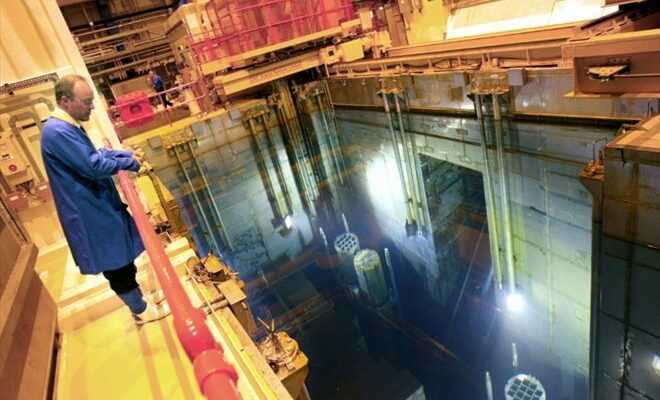British Energy Minister Kwasi Kwarteng at COP26 in Glasgow, November 4, 2021 (AFP/Archives/Daniel LEAL)
A few months ago, the United Kingdom hosted the COP26 international climate conference and London’s energy strategy focused on the transition to carbon neutrality. Since then, the war in Ukraine and inflation have changed the situation.
The Conservative government unveiled a new energy security strategy on Thursday that wants to accelerate nuclear, wind, solar, but also fossil fuels in the North Sea, which has drawn criticism from NGOs and the opposition. .
There is however “no question at all” of reducing the priority of the United Kingdom’s climate commitments, assured Thursday morning the Minister of Energy, Kwasi Kwarteng on SkyNews.
But “given what is happening in the world (…) we are also acting to restore its energy independence to the United Kingdom”, he justified.

Boris Johnson during a visit to Moray Offshore Windfarm East off the Aberdeenshire coast on August 5, 2021 (POOL/AFP/Archives/Jane Barlow)
The country will “never again be blackmailed by people like (Russian President) Vladimir Putin”, added Prime Minister Boris Johnson, who is targeting “nearly half of the country’s energy capacity coming from offshore wind from ‘here 2030’.
Mr. Johnson also intends “to completely revive the nuclear industry, which I fear was more or less moribund in this country”, he added while visiting Thursday the construction site of the Hinkley Point nuclear power plant, the only one under construction in the country.
Critics targeted Thursday the choice to produce more hydrocarbons but also a strategy that will take years to bear fruit, without doing anything in the short term to reduce the energy bills of the British, who are blazing.
– Madness –

The project on an electronic image of the two nuclear reactors at Hinkley Point in the southwest of England, in London on July 28, 2016 (EDF ENGERY/AFP/Archives/Hayes DAVIDSON)
Despite “some improvements on renewable energy targets” the government has “prioritized slow solutions”, deplores Greenpeace UK.
The new plan “supports new oil and gas licenses” in contradiction with the country’s climate objectives tackles the NGO, stressing that these new drillings “take an average of 28 years to start”.
UN Secretary-General Antonio Guterres on Monday called new investments in fossil fuels “economic and moral folly” in light of the climate emergency.
But Kwasi Kwarteng no longer hesitates to affirm on the contrary that it would be “completely crazy” for the United Kingdom “to turn off the tap on (its) national source of gas in such an uncertain world”.
In response to the invasion of Ukraine, London announced the end of its imports of Russian oil by the end of the year, and if the country is less dependent on Russian hydrocarbons than other European countries, like Germany, oil and gas still weigh 75% of its energy mix.

EPRs around the world (AFP/Vincent LEFAI)
Accused of inaction in the face of Britons forced to choose between heating or food, Downing Street is under pressure, especially in the run-up to local elections in May.
Kwasi Kwarteng admits that drilling more locally will not bring down gas prices, which follow international market prices. “So we need to generate more electricity in Britain” with renewables and nuclear, he insists.
– Aging nuclear fleet –
But if the United Kingdom plans to accelerate the development of the atom and to build eight new power plants thanks in particular to small modular reactors built by Rolls Royce, it will be necessary to be patient because they will still require years of development.

Originally named Windscale, the site was renamed Sellafield following a serious accident in one of its reactors in 1957, in Sellafield in the north of England, September 26, 2002 (AFP/Archives/ODD ANDERSEN)
Great Britain currently has 15 reactors on eight sites, but many are at the end of their life and Hinkley point, a project carried out by EDF and the Chinese CGN, has seen its costs soar and will not open before 2026.
Aiming for a 95% share of low-carbon electricity by 2030, London is also looking, in the longer term, towards the promising technology of “green” hydrogen and tidal energy.
Conversely, hydraulic fracturing and onshore wind power will not have a central role because of “strong local opposition”, the Minister of Energy recently indicated.
Onshore wind is however “the cheapest and fastest source of energy” to implement, criticized Thursday Ed Miliband, responsible for climate change for the Labor opposition.
But this energy “has been blocked since 2015” not because of public opinion but of “a few Conservative MPs who are holding the government’s energy policy hostage”, according to him.
© 2022 AFP
Did you like this article ? Share it with your friends with the buttons below.




